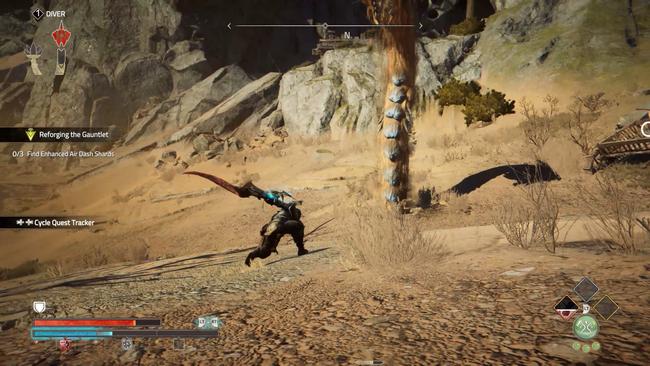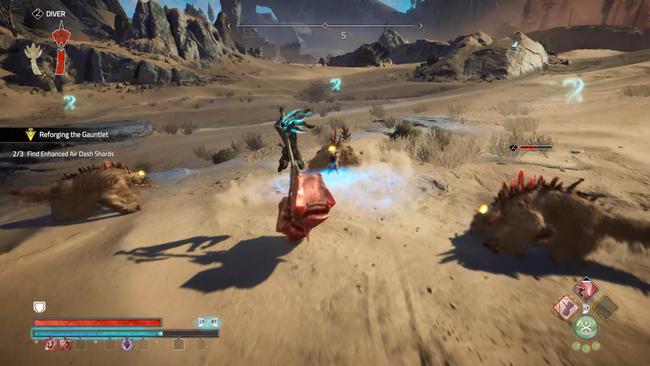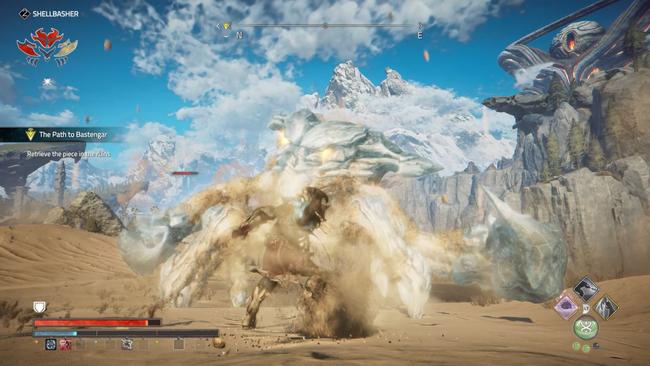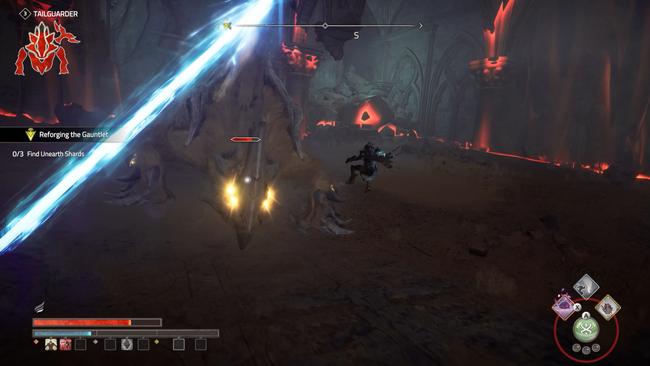
Hands-on with Atlas Fallen: A bit of Darksiders, God Eater, and... Vagrant Story?
Developer Deck13 has been dormant since 2019’s The Surge 2 for good reason. Atlas Fallen is a remarkable change from their well-known Soulslike duology; they have their sights set on delivering a brand-new open-world action RPG now. Its ambition and scope is a considerable step-up from their work on The Surge previously.
I was given the opportunity to play a small slice of Atlas Fallen for several hours and it left me optimistic with how well it played.

The combat system in Atlas Fallen has been the star of the show so far. There’s an immediate satisfaction in the way it balances risk-versus-reward to players. The custom created character in Atlas Fallen wields a mysterious gauntlet that has the ability to shape-shift into multiple weapons as players attack enemies.
Primary attacks are meant for close-ranged assaults, while secondary attacks reach further enemies and can even grapple onto them for players to quickly close the gap.
What sets Atlas Fallen apart from other modern battle systems is the blue bar underneath the red HP bar - the Momentum Gauge. It gradually fills as players land attacks on foes. Notice how the bar is divided up into three segments in the above screenshot? These indicate the current ‘Tier’ that the player’s moveset is in. Players start at Tier 1 and can reach up to Tier 3. Each Tier transforms the gauntlet’s arsenal into bigger and more lethal weapons.

The weapon provided in this preview build of Atlas Fallen has the gauntlet transformed into a small ax on its primary attack and thin dagger whip on its secondary attack for Tier 1. Advancing into Tier 2 turns the primary weapon more into a considerably sized scythe, while the secondary weapon is a thicker whip with a sword at the end of it. If an encounter lasts long enough for the main character to reach Tier 3, their primary becomes a gigantic hammer and their secondary morphs the whip into a myriad of sword bits that circle around players, like the Gundam 00 Qan[T]. Seeing my weapon gradually shift into an oversized monstrosity reminded me of how God Eater’s ludicrously sized weapons became even bigger when their Devour mechanic literally transformed them into a raging beast’s head ready to take a bite out of enemies. Tier 3 gave me the same feeling of unwieldy devastation.
Keep in mind that this arsenal is just “one” weapon that the gauntlet can equip, so I’m very curious and excited to see what other weapons Atlas Fallen has in store.
Players can also slot in abilities, known as Essence Stones, into different Tiers. Each Tier allows access to one active ability and up to three passive abilities. Most Essence Stones acquired later in the preview build were recipes that needed a certain amount of materials first, before they were fully available to slot in and out onto my character.

Advancing into Tier 2 and Tier 3 does come at a cost though. Players take more damage the higher their Tier is. An attack that may have originally taken away a fifth of a full health bar at Tier 1 now easily slices off half at Tier 3, instead. Oddly enough, this reminded me of the Risk system in Vagrant Story where the player’s offensive capabilities were enhanced the higher the Risk value was, in exchange for drastically reduced defensive capabilities.
There is a way to quickly return to Tier 1 in the middle of a fight though, if a player wants to slow things down once more. At a certain point in the preview build, the main character unlocks a finisher attack that players can activate at any time once they reach at least Tier 2. They can expend all of their Momentum Gauge for a big attack that becomes even more deadly if it’s activated during Tier 3. I should also mention that the Momentum Gauge resets back to 0 in-between new enemy encounters too; it isn’t preserved in-between encounters like Vagrant Story’s Risk level.
Luckily, there are several powerful defense tools given to Atlas Fallen players that may be a bit concerned with its delicate balance of risk-versus-reward. There is the typical dodge roll that is instantly performed even mid-combo string and animation; very few moves are animation locked from performing it.
More importantly, there is the Stoneskin shield mechanic in Atlas Fallen. Stoneskin is basically the player’s parry button for incoming attacks. A red flash indicates that a nearby foe is about to strike and the attack it’s performing is parryable. Simply tap the Stoneskin button when the red light flashes to not only block the attack, but crystalize that enemy as well. The crystallization freezes them for a few moments for the character to whale on them freely. Bigger enemies often need three to four Stoneskin counters before they become completely crystallized, though each successful Stoneskin has crystals visibly build up on their skin gradually, providing a cool visual effect on them.
Just like the dodge roll, Stoneskin activates immediately even in the middle of an attack string. I appreciated the small detail upon pressing the Stoneskin button because, as its name implies, it covers the entire main character’s model in a mold of rock for a split second to reflect attacks. This is true for any animation the character model is doing, so if the model’s pose is currently in the middle of an attack stance, the Stoneskin effect will make an exact mold of the character’s pose when the button is pressed.

Healing in Atlas Fallen is done with charges, rather than consumable items. The preview build allowed players to store three healing charges, but they were gradually refilled as long as players continued to attack enemies. The more powerful their attacks, the faster it would refill so maintaining a higher Tier would let them replenish their healing tools faster. They were also refilled upon visiting an anvil waypoint for the first time, which are Atlas Fallen’s rest spots to manually save the game and make upgrades to their character.
On top of all this, there’s a large emphasis on aerial combat in Atlas Fallen also. There is a specific button that launches enemies into the air, if a player is on the ground, and that same button initiates a falling attack from the air to the ground, if a player is in the air. Normally, players can only do a single combo string in the air before having to land back on the ground, but pressing the dodge roll button while airborne lets their character air dash which replenishes their actions to extend combos.
Now if they hit an enemy at least once when airborne, that allows them to air dash again.
Players can essentially stay in the air indefinitely if they so choose, as long as they’re managing the flow of replenishing their air dashes through attacks. A main story upgrade even unlocks the ability to air dash twice consecutively which allows for greater movement options out in the open world and in battle.
The trickiest thing to adjust to was simply getting used to the controller layout of what each button does, since almost every button is essential in the middle of combat. Primary and secondary attacks are on Square/X and Triangle/Y respectively, while Stoneskin is on L1/LB and dodge roll (or air dashing) is on R1/RB. Holding down L2/LT gives access to the character’s active skills on the face buttons, while the healing charges are always on the bottom face button so it’s L2/LT + X/A to consume a healing charge. Meanwhile, the launcher (or falling) attack is mapped to R2/RB. It’s a lot to get used to a first, especially in busier combat situations, but with a little bit of practice I began to wrap my head around it.

There’s still a lot to talk about when it comes to other elements of Atlas Fallen, but for now I just wanted to give a thorough breakdown of what people can expect in how it plays. A lot of its cadence and flow from traversal to gameplay reminds me of the first Darksiders game, which is a big plus in my book.
I especially enjoyed fighting bigger monsters that had multiple body parts to break off. The game will give an indicator of which body parts deal HP damage to them, while breaking off other parts of its body will drop additional treasure in exchange for making their behavioral patterns more aggressive along with increasing their damage output.
Anyway, this first slice of Atlas Fallen has made me very optimistic about its final release. It nailed the important part down - it feels fun to play. I was just very amused that a new 2023 release reminded me of Vagrant Story and that’s neat but also, look at me, I’m old as hell.